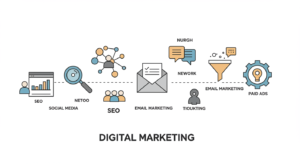In Nigeria’s growing digital economy, having a website that merely exists isn’t enough—it needs to convert visitors into customers. With internet penetration reaching 51% in Nigeria and e-commerce revenue projecting steady growth, businesses must optimize their websites for maximum conversion. This guide will help you create a website that not only attracts visitors but turns them into loyal customers.
Understanding the Nigerian Web User
Before diving into technical elements, let’s understand key characteristics of Nigerian web users:
- 85% access websites via mobile devices
- Average internet speed is 18.72 Mbps
- Payment preferences include bank transfers, cards, and USSD
- Users value clear pricing and trusted security badges
- Preference for websites that load quickly and consume less data
Essential Elements of a High-Converting Website
1. Fast Loading Speed
Speed is crucial for Nigerian websites due to varying internet connectivity:
- Optimize images using WebP format
- Implement browser caching
- Use a Content Delivery Network (CDN)
- Minimize HTTP requests
- Enable GZIP compression
Impact on Conversion: Studies show that a 1-second delay in page load time can reduce conversions by 7%.
2. Mobile-First Design
With most Nigerian users accessing websites via mobile:
- Implement responsive design
- Use larger touch targets for buttons
- Ensure readable font sizes on small screens
- Optimize forms for mobile input
- Test across various devices and screen sizes
3. Clear Value Proposition
Your website should immediately answer:
- What you offer
- How it benefits the customer
- Why choose you over competitors
- What makes your business unique
4. Trust Elements
Build credibility with:
- Security badges and SSL certificates
- Customer testimonials
- Client logos
- Industry certifications
- Clear contact information
- Physical address (if applicable)
5. Optimized Navigation
Create a user-friendly structure:
- Clear menu organization
- Search functionality
- Breadcrumb navigation
- Call-to-action buttons
- Easy access to important pages
6. Local Content
Customize content for Nigerian audiences:
- Use relatable examples and case studies
- Include local currency (₦)
- Incorporate familiar payment methods
- Address common local concerns
- Use culturally appropriate images
Website Audit Checklist
Technical Performance
- Page load time under 3 seconds
- Mobile responsiveness
- Browser compatibility
- Working links and buttons
- Form functionality
- SSL certificate
- Backup system
- 404 error page
User Experience
- Clear navigation menu
- Logical information hierarchy
- Consistent design elements
- Readable typography
- Appropriate color contrast
- Working search function
- Clear call-to-action buttons
- Contact information visibility
Content Quality
- Unique value proposition
- Clear product/service descriptions
- Updated pricing information
- Quality images and videos
- Grammatically correct content
- Local context and relevance
- Trust indicators
- FAQ section
SEO Elements
- Optimized meta titles and descriptions
- Proper heading hierarchy
- Alt text for images
- XML sitemap
- Robots.txt file
- Local SEO optimization
- Mobile optimization
- Schema markup
Security and Legal
- Privacy policy
- Terms and conditions
- Cookie consent
- Secure payment gateway
- Data encryption
- Regular security updates
- NDPR compliance
- Copyright information
Implementation Strategy
Phase 1: Planning and Research
- Define website goals
- Identify target audience
- Research competitors
- Plan content structure
- Choose technology stack
Phase 2: Design and Development
- Create wireframes
- Design mobile-first layouts
- Develop responsive templates
- Implement core functionality
- Install security measures
Phase 3: Content and Optimization
- Create compelling content
- Optimize for search engines
- Implement tracking tools
- Test user experience
- Launch and monitor
Cost Considerations
Basic Website (₦150,000 – ₦300,000)
- Simple design
- Essential pages
- Basic SEO
- Mobile responsive
- Contact form
Professional Website (₦300,000 – ₦800,000)
- Custom design
- Content management system
- Advanced SEO
- E-commerce functionality
- Security features
Enterprise Website (₦800,000+)
- Custom functionality
- Advanced security
- Integration capabilities
- Premium hosting
- Maintenance support
Measuring Success
Track these key metrics:
- Conversion rate
- Bounce rate
- Average session duration
- Pages per session
- Mobile vs desktop usage
- Load time
- Form completion rates
- Cart abandonment rate (for e-commerce)
Common Pitfalls to Avoid
- Overlooking mobile optimization
- Ignoring page speed
- Complex navigation
- Poor content organization
- Weak security measures
- Inadequate call-to-action
- Neglecting local context
- Poor form design
Next Steps
- Conduct a thorough website audit using the checklist provided
- Prioritize improvements based on impact and resources
- Implement changes systematically
- Monitor performance metrics
- Gather user feedback
- Make continuous improvements
Need professional help with your website development? Contact our team for a consultation.




